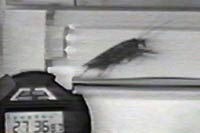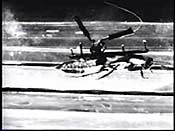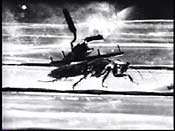| |
In
the PolyPEDAL Lab, animals show the way
Squeamish
students might want to avoid Robert Full's PolyPEDAL
Lab, where the test subjects are cockroaches, crabs, beetles,
ants, centipedes, millipedes and various lizards.
"I
personally think cockroaches are repulsive," says
Full. "But you don't have to like them to find
them interesting." The lab seeks to understand
how many-footed animals move from many different perspectives:
what kind of control system they use, how their skeletons
and muscles factor into the motion, and how they interact
with their environments to overcome or avoid obstacles.
"We
follow the August Krogh principle, which says that for many
problems, there is an animal you can study as the best model,"
explains Full.
Jell-O
running tracks
As
the name PolyPEDAL suggests (it stands for many-footed —
the "poly" part — plus Performance, Energetics,
Dynamics of Animal Locomotion), Full and his student assistants
study every facet of animal movement. They employ instruments
such as treadmills and force platforms that are sensitive
enough to measure even a running ant's side-to-side energy.
To capture the force exerted by a single tiny foot, they built
a special platform with photoelastic material sandwiched between
two polarizing filters then beamed light through all three.
Where an animal sets a foot down, light penetrates the filters
and is captured by a camera.
(The
initial version of the photoelastic material was store-bought
Jell-O; when the insects proved to be more interested
in eating the material than walking on it, Full switched
to plain gelatin.)
Alternating
tripods and pogo-stick principles
The
first surprising discovery Full and his students made about
multi-legged animal locomotion was that rather than moving
like a wheel — raising and lowering each leg in turn,
as previous observers had supposed — instead they follow
the same bouncing principle as a running human. Two legs on
one side and one leg on the other form a tripod that acts
like one of our legs, while the opposing leg-tripod swings
forward. Arthropods with more than six legs, such as centipedes,
also follow this principle, with groups of legs from the front,
mid, and rear sections forming the tripod.
Multi-legged
animals move like their biped cousins in other ways.
Aided
by force platforms and high-speed cameras, Full's team found
that crabs exerted the same force patterns when running as
humans do. When animals run, says Full, their legs become
like pogo sticks equipped with shock absorbers and springs.
"Crabs may look completely different — they run
sideways, they have different numbers of legs, they have their
skeleton on the outside, and they're cold-blooded — but
they bounce along just like humans do," says Full. As
it turns out, crabs, insects, lizards and other animals also
generate the same amount of mechanical energy per pound of
body weight as humans do when we walk or run.
 |

And
he's off: a bipedal sprinting roach
|
(Another
wacky congruence between the bug world and ours: At
top scuttling speeds, the roach actually rears up on
its hind legs — which are longer than its front
and middle pairs — and runs upright, like a human
sprinter. The roach is also the world's fastest land
insect, able to run the human equivalent of 200 miles
per hour, as Full's students relished informing the
Guinness Book of World Records.)
To
learn how insects correct their motion after being knocked
off-stride, Full and his students mounted a tiny cannon
on the insect's back. The bug-backed cannon fired a
pellet, giving the researchers an exact known perturbation
to measure against the insect's recovery. They
discovered that the animal self-stabilized, regaining
its equilibrium without any feedback from the brain.
This, they deduced, was from the built-in springiness
of the legs: push to one side, and the legs recover
on their own.
Lesson
learned: by incorporating springiness into robot legs,
Full's collaborators were able to simplify the units'
control systems.
 |
 |
 |
| A
roach with a tiny, pellet-firing cannon mounted
on its back to measure how it reacts to perturbation. |
As
the cannon fires, the roach stumbles. |
Within
a few strides after the disturbance, the roach's springy
legs self-correct. |
Don't
fence me in
To
study how animals interact with their environment, says
Full, "we chose geckos, because they can run on
any surface and go anywhere."
Geckos
can run up a wall effortlessly, as fast as a meter per second,
and they can hang from the ceiling supported by just one foot.
As Full and his fellow researchers studied the gecko's feet,
they discovered something amazing. Its toes operate like those
party favors that uncurl as you blow, then retract into a
circle. When the gecko's toes unfurl, they stick to surfaces;
to move on, they peel them off, just like removing tape from
a wall ... only 30 times per second.
How
do they do it?
Full
found that the millions of tiny branched hairs on gecko toes
— imagine if your split ends had split ends that had
split ends— can generate enormous amounts of force. Not
by suction, or interlocking into cracks, or glue, but by using
the weak intermolecular forces that hold atoms together. His
engineering collaborator here at Berkeley, Ron Fearing, has
managed to synthesize the tip of one of these hairs (for details,
read the news
release). Soon, a gecko toe hair could inspire the first-of-its-kind,
self-cleaning adhesive.
|
|